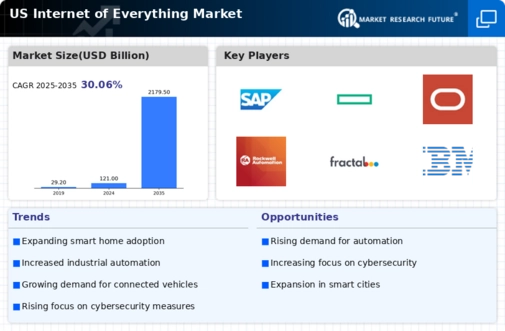The US Internet of Everything Market is characterized by rapid technological advancements and a dynamic competitive landscape, where companies aim to capitalize on the convergence of big data, artificial intelligence, and connected devices. As industries undergo digital transformation, organizations are increasingly seeking innovative solutions that can enhance operational efficiencies, facilitate real-time insights, and drive value creation. Companies operating in this market are tasked with not only developing advanced IoT solutions but also ensuring interoperability across various platforms, addressing security challenges, and adhering to evolving regulatory standards.
The competition is intensifying as players leverage partnerships, mergers, and acquisitions to build comprehensive IoT ecosystems and expand their market reach.SAP has established a strong presence in the US Internet of Everything Market, excelling in providing enterprise software solutions that enhance business processes across various sectors. The company’s strengths lie in its ability to integrate IoT capabilities within its existing platforms, allowing clients to harness real-time data for better decision-making. SAP’s robust cloud infrastructure and emphasis on security and scalability have positioned it favorably among enterprises looking for reliable IoT solutions.
Additionally, the company has invested heavily in research and development, continuously innovating to meet the unique needs of its customers in the US. This commitment to fostering strategic partnerships has further amplified SAP’s competitive advantage, enabling it to maintain a significant share in the evolving IoT landscape. Hewlett Packard Enterprise is equally prominent in the US Internet of Everything Market, providing comprehensive solutions that encompass edge computing, networking hardware, and analytics tailored for IoT applications.
The company's strengths are evident in its ability to deliver end-to-end solutions that are both flexible and secure, catering to various industries looking to capitalize on connected technology. Hewlett Packard Enterprise's strong market presence is bolstered by its innovative products and services, including IoT platform solutions that facilitate seamless data integration and management. The company's strategic mergers and acquisitions have further enhanced its capabilities and expanded its portfolio, ensuring its competitiveness in a rapidly evolving environment.
Focused on meeting the demands of US enterprises, Hewlett Packard Enterprise continues to adapt and innovate, striving to provide solutions that empower organizations to thrive in the complex landscape of the Internet of Everything.























Leave a Comment